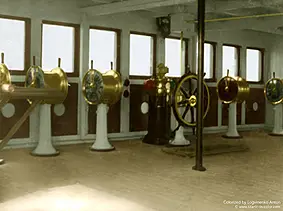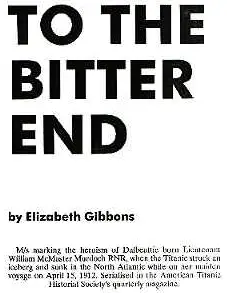14. Ice Warnings
No severe weather was encountered, while the ship herself impressed even the professionals. Lightoller's Senate testimony conveys the pleasure on the bridge at the absence of vibration and ease of passage, as do the memoirs of Second Class passenger Lawrence Beesley. Beesley had never before crossed an ocean, and his observations sparkle with delight in the elegant surroundings and the stillness of the ship; except for an almost imperceptible movement upwards and downwards, the Titanic seemed to those enjoying its splendors as if immobile. The voyage, in fact, was almost monotonous. There is, in any event, no indication anywhere that Murdoch or Lightoller were concerned by route or speed or being entrusted with the largest ship in the world. Nor is there any indication that Captain Smith's instructions aroused any qualms: trained to obedience anyway, neither seems to have wondered why Smith canceled the boat drill scheduled for Sunday morning, April 14th.
Murdoch and Lightoller did, however, consider the situation in that portion of the North Atlantic through which they knew they must pass. The presence of unusual amounts of ice as distinct to sheer bad weather was not a mystery. Captain Smith and his senior officers, in fact, would have heard about the unexpectedly heavy ice on the North Atlantic while Titanic was still in Belfast. All through late March and early April ice warnings had been appearing in the newspapers and passing from ship to ship, indicating heavy field ice and icebergs in the area through which Olympic, Titanic and other liners were expected to pass to and from the United States. On April 10th, the French liner Niagara struck ice; she slid along, buckling plates below the waterline, and forthwith sent out a distress call. Within a short time, the CQD was canceled; her captain had discovered that Niagara was not badly damaged, and could continue without assistance. On April 12th, the Allen liner Corsican struck an iceberg, and limped into St. Johns, Newfoundland, on April 14th; no position was given for the collision, but on April 12th it is possible that she was within reach of Titanic's powerful wireless. If so, it is unlikely that her senior officers were not advised by either Jack Phillips or Harold Bride in the Marconi room of such a dramatic event.

Neither the Niagara nor the Corsican incident, assuming that word of them reached the bridge, would necessarily have reinforced any sense of caution on the Titanic; while hitting ice was as undesirable as hitting another ship the lucky escapes of Niagara and Corsican were not particularly unusual. Both were moving slowly at the time of collision, but ships steaming at higher speeds had also escaped serious damage. In July of 1907, the great North German Lloyd liner Kronprinz Wilhelm, one of the giants of the day, hit an iceberg while traveling at 16 knots; the Kronprinz struck on the buff of her starboard bow and slid along the berg. She arrived at her pier in Hoboken, New Jersey, on July 11th, her damage described on Page 7 of the New York Times as "slight". In July of 1909, the Bona Vista hit an iceberg off Cape Race, and crept into St. John's on July 27th. On August 5, 1911, the Anchor Line's Columbia struck an iceberg bow on, 100 miles off Cape Race. She arrived in New York two days later and by August 20th had completed repairs at the Brooklyn yards and was ready to sail.
How many wireless warnings were actually received, besides those of the Caronia, the Baltic and the Amerika which became publicly known, cannot be reconstructed; there is no way to know how many messages were taken to the bridge nor when. April 12th was a day on which the airwaves were littered with ice warnings from ship to ship and from ships to the great shore stations of North America; as Titanic had one of the finest sets available, a good many of these messages could have been overheard, but which ones, if any, other than the warnings specifically directed to Titanic were intercepted and sent to the bridge vanished with the Marconi room log book.
Lightoller would claim that the immediate cause of the collision was the failure of the warning from the steamer Mesaba to be delivered to the bridge. The Mesaba's message late on April 14, 1912, indicated ice directly in Titanic's path and not far ahead, but no one can say with certainty that it was not delivered to the bridge, as Lightoller could only know that he had not received it. It is always possible that it was delivered after he was relieved by Murdoch at 10:00 pm. Lightoller would also claim, in the 1936 BBC recording, that had he known of the Mesaba wireless he would have reduced Titanic's speed by half and sent for her commander at once, volunteering the opinion that Smith would then have stopped altogether and waited for daylight. If Murdoch did get the wireless, he obviously did not believe such precautions necessary.
There was also at least one ice warning from a passing ship. The Furness Withey liner Rappahannock, outward bound from Halifax, passed the Titanic late on Saturday night, April 13, 1912. Chief Officer Albert E. Smith of the Rappahannock, interviewed in London on April 26, 1912, stated that his ship had just emerged from a "rain squall" and found herself abeam of the Titanic. The Rappahannock had come through that extensive and highly dangerous icefield and had sustained severe damage, including a twisted rudder, despite speed Smith described as "dead slow". The Titanic was steaming at what Smith estimated to be 21 knots, and he had sent her an ice warning. The warning was acknowledged. Fifty years later, Albert Smith wrote a letter to the Daily Telegraph (April 4, 1962) in which he added the information that he had personally signaled the Titanic meaning morse lamp and received the acknowledgment. He was as puzzled and astonished in 1962 as he had been in 1912 that the Titanic had struck ice; the bergs that he had seen, Smith said, should have been "seen and avoided."
The Rappahannock was going east in the westbound lanes. Although nobody asked Smith what distance he estimated the Titanic to be when he signaled her, two to three miles would be a safe surmise. Only the curvature of the earth and the foulness of the weather are absolute barriers to morsing, but sending a complicated message to a far speedier vessel going the opposite way strongly suggests not more than a few intervening miles.

Titanic's bridge (colourised). (19.)
During the noon hours of April 14th, 1912, an ice warning was handed to Captain Smith on the bridge; Smith promptly repeated it to Lightoller. Murdoch was then on duty but had been relieved for lunch. Upon his return at approximately 1:00 pm, Lightoller passed on the warning; Murdoch's reply was "All right". (Page 63) Between this message, received in a calmly professional manner, and the purportedly non delivered Mesaba wireless there is a void; for unknown reasons Titanic's wireless failed for four hours, and was only put right by its exasperated operators in the evening hours hence, the backlog of passenger cables and Jack Phillips' irritable interruption of the Californian's ice report.
There was, in sum, every reason for Titanic's officers to be wary of ice but none actually to fear it. The settled solution, based upon experience, was to rely upon seeing ice in time to avoid it. In the evening hours of April 14th, Captain Smith was on and off his bridge, joining Lightoller at five minutes to 9:00 pm:
Mr. Lightoller: Yes. We spoke about the weather; calmness of the sea; the clearness; about the time we should be getting up toward the vicinity of the ice and how we should recognize it if we should see it freshening up our minds as to the indications that ice gives of its proximity. We just conferred together, generally, for 25 minutes. (Page 67)
Leaving behind the standard commander's injunction to be summoned should there be doubt of anything, Captain Smith retired to his quarters. Lightoller instructed Sixth Officer James Moody to advise the crow's nest lookouts to be particularly watchful for small ice and growlers. The night was a blackness that glittered, cold, moonless and still, each star distinct to the horizon, the sea an oily, wriggling dark against Titanic's darker hull. There was, Lightoller would tell the BBC, "Nothing to see, nothing to hear", save for the distant roar of waves off the bow.
